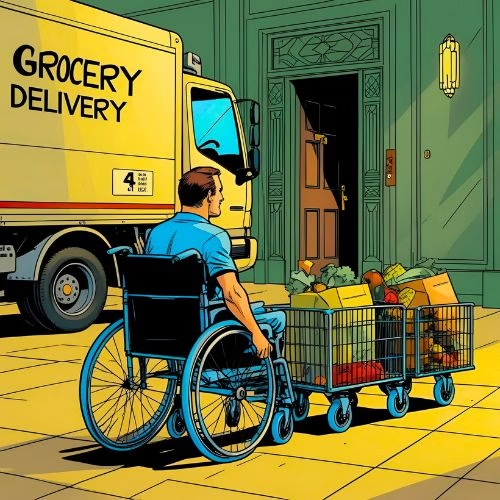🗣️Intro to Meal Planning and Nutrition
Frankly, being housebound brings its own daily challenges. Commonly, people have limited mobility or energy levels. Often, meal times can feel overwhelming. Thus, figuring out what to eat without added stress is vital. Especially when your body or circumstances need extra care. So, that’s why meal planning for housebound life isn’t just a comfort.
Actually, it’s a powerful way to reduce daily stress. Which can help you save precious energy. Yet, it also enables you to get a balanced mix of vitamins, minerals, and protein that your body needs. Therefore, with a bit of preparation, you can take the guesswork out of mealtimes. Then, you make feeding yourself feel a lot more effortless.
🍽️Why Nutrition Matters When Housebound
Well, eating balanced meals is essential not just for your body. In fact, it’s also good for your mental health. When you’re housebound, good nutrition helps maintain muscle strength. Also, it supports your immune system. Seriously, it can even improve mood and energy levels.
So, to get a clearer picture of what a balanced diet means, here’s a quick overview. Below, find the recommended daily intake for key nutrients. Simply, vitamins, minerals, and protein are broken down by men and women:
| Nutrient: | Men aged 19-50 | Men aged >50 | Women aged 19-50 | Women aged >50 |
|---|---|---|---|---|
| Sodium | 1,500mg | 1,500mg | 1,500mg | 1,500mg |
| Potassium | 3,400mg | 3,400mg | 2,600mg | 2,600mg |
| Magnesium | 400mg | 420mg | 320mg | 320mg |
| Zinc | 11mg | 11mg | 8mg | 8mg |
| Calcium | 1000mg | 1000mg | 1000mg | 1000mg |
| Selenium | 55mcg | 55mcg | 55mcg | 55mcg |
| Iodine | 150mcg | 150mcg | 150mcg | 150mcg |
| Iron | 8mg | 8mg | 18mg | 18mg |
| Vitamin A | 900mcg | 900mcg | 700mcg | 700mcg |
| Vitamin C | 90mg | 90mg | 75mg | 75mg |
| Vitamin D | 15mcg | 15mcg | 15mcg | 15mcg (20mcg >age 70) |
| Vitamin E | 15mg | 15mg | 15mg | 15mg |
| Vitamin K | 120mcg | 120mcg | 90mcg | 90mcg |
| Thiamin (B1) | 1.2mg | 1.2mg | 1.1mg | 1.1mg |
| Riboflavin (B2) | 1.3mg | 1.3mg | 1.1mg | 1.1mg |
| Niacin (B3) | 16mg | 16mg | 14mg | 14mg |
| Pantothenic Acid (B5) | 5mg | 5mg | 5mg | 5mg |
| Pyridoxine (B6) | 1.3mg | 1.7mg | 1.3mg | 1.5mg |
| Folate (B9) | 400mcg | 400mcg | 400mcg | 400mcg |
| Cobalamin (B12) | 2.4mcg | 2.4mcg | 2.4mcg | 2.4mcg |
| Protein | 56g | 56g | 46g | 46g |
| Fat | Not determined | Unknown | Not defined | Undetermined |
| Carbohydrates | 130g | 130g | 130g | 130g |
| Fibre | 38g | 30g | 25g | 21g |
| Water | 3.7 litres | 3.7 litres | 2.7 litres | 2.7 litres |
Note: Pregnant ladies may require adjusted amounts, but you’ll check that with your healthcare provider. Figures in the table above were obtained from the UK National Institutes of Health (Office of Dietary Supplements).
Your Dietary Needs Change When You’re Housebound
Typically, your nutritional needs can shift due to housebound life. Often, you have reduced physical activity and health issues. For example, you might need more protein to preserve muscle. Perhaps you need extra fibre to aid digestion. Sometimes your appetite can drop. Therefore, you will need nutrient-dense meals.
Well, there are some common pitfalls to avoid. Often, when you’re too low on energy, you may skip meals. Which increases your low energy! Next, we reach for a sugary snack that is low in nutrients. Then, we get busy and forget hydration. So, the best way to avoid these traps is to plan snacks and meals. Ensuring that they include a variety of food groups. You need lean proteins, whole grains, fruits, vegetables, and healthy fats. Also, remember to keep hydrated throughout the day.
🗓️ Understanding Meal Planning for Housebound Living
Well, meal planning might sound complicated. Like, something only busy families do. However, at its core, it’s simply deciding ahead of time what you’ll eat. Helpfully, this takes the guesswork out of mealtimes. As well as stopping last-minute stress.
Yet, meal planning for housebound living offers more than just comfort. It can bring predictability to your day. Also, it preserves brain energy by reducing the need for repeated decisions. Not only that, it might help avoid food boredom by enabling variety. Planning also means you can order exactly what you need. Basically, it prevents the ordering of too much of one thing and none of another. Which saves money and fridge space.

Now, a big plus in modern life is the ability to use supermarket apps. On many, you can set up your ‘favourites’ or ‘regular items.’ Just add your staple groceries and preferred products to these apps. Then, you can reorder quickly and confidently whenever you need to. This perfectly fits the “plan once, eat many times” mindset. Ultimately, it saves you time and energy repeatedly.
🥪 The ‘Grab Food’ Strategy for Instant Healthy Eating
On low-energy days, a grab-and-go meal is your best friend. Actually, it’s my favourite way of meal planning for housebound days. Typically, these are no-preparation snacks that are healthy and ready to eat. In fact, they are not heavily processed convenience foods.

Some examples include:
- Mini cheeses or soft cheese to spread;
- Whole nuts;
- Fresh fruit;
- Refrigerated hard-boiled eggs;
- Pre-cooked sliced meats;
- Smoked fish, preferably without the bones;
- Pates;
- Crunchy pickles;
- Unsweetened yoghurt;
- Crispbreads with healthy spreads;
- Protein bars made with natural ingredients.
However, if you choose a processed snack, keep it to a minimum. Avoid products high in refined sugar, hydrogenated oils, or artificial additives. Do check the ingredients list. After all, if you can’t pronounce half of it, it’s probably not the best choice.
Note: Grab food is different from batch cooking. Mainly, it’s about quick access to food with no effort. So you can stay nourished without draining your energy.
🥘 Batch Cooking for Housebound Life
So, batch cooking means preparing larger portions of meals or ingredients in one session. For instance, organising a large quantity of ingredients to make multiple servings of your favourite dish at once. Afterwards, you cook, bake, or freeze in smaller portions. Finally, you store the individual portions for later use. Basically, it’s about cooking once and eating several times.
So, for housebound living, this could be:
- Cooking a big pot of soup and freezing portions.
- Roasting extra vegetables to use across different meals.
- Making double portions of pasta sauce for the fridge or freezer.
- Cooking grains like rice or quinoa for the week ahead.
Thus, batch cooking helps you avoid starting from scratch each day. Besides, it’s flexible. Simply mix pre-cooked items with grab food each day for quick, balanced nutrition. Also, choose recipes that store well and can be reheated easily. Then, you’re set for days when energy is low.
💡 How Meal Planning for Housebound Life Saves Energy
Really, planning meals ahead isn’t just about eating. Actually, it’s also about saving your physical and mental energy. Even small steps can make a difference. Like, prepping ingredients or cooking in batches. Little things that can help lighten your daily load.
So, if you can manage it, consider batch cooking simple meals. Perhaps you chop vegetables in advance, then store them in the fridge. Honestly, I buy everything pre-chopped, pre-grated and pre-pulped! For instance, on low-energy days you can combine these with grabbing food for extra flexibility. This means you can enjoy a healthy meal without having to cook or think too much about it.
⚖️ Checking and Adjusting Nutrition for Health Challenges
Typically, those of us who are housebound fall under three categories. Sometimes, it’s a chronic illness, or mobility challenges, or mental impairment. Whichever, your nutrition needs may vary from those of non-disabled people. Also, they aren’t the same for everyone. Therefore, guessing your nutrient needs can be difficult. Hence, it’s worth starting with facts.
So, one option is to find out your nutrient levels through a blood test. This can show if you’re low (or high) in specific vitamins or minerals. Alternatively, write down everything you eat for a week. Then, check the nutrient values using a reputable database (see Additional Resources). Ultimately, this gives you a clearer picture of where you’re starting from.
From there, you can make dietary adjustments. Whether that’s adding more protein for healing, adjusting fibre for digestion, or balancing overall nutrient intake.
Using Meal Planning for Housebound Life to Spot Trigger Foods
Likewise, it can help to identify foods that may be contributing to low energy, stomach pain, bowel issues or inflammation. One well-researched approach is the low FODMAP diet. Now, FODMAP stands for Fermentable Oligosaccharides, Disaccharides, Monosaccharides and Polyols. Simply, these are certain carbohydrates that some people find hard to digest. So, the diet works by removing all high-FODMAP foods for a set period. Then, you reintroduce them one at a time to see which causes symptoms. This process is best done under the guidance of a dietitian to ensure you still meet your nutrient needs.
Examples of High FODMAP Foods
(These are removed temporarily during the elimination phase, then slowly reintroduced.)
- Fruits – apples, pears, mangoes, cherries, watermelon.
- Vegetables – onions, garlic, cauliflower, mushrooms, asparagus.
- Legumes – lentils, chickpeas, kidney beans, baked beans.
- Grains – wheat, rye, barley (in breads, cereals, pasta).
- Dairy – milk, soft cheeses, yoghurt (regular, not lactose-free).
- Sweeteners – honey, high-fructose corn syrup, sorbitol, mannitol, xylitol.
Alternative Diet Approaches in Meal Planning for Housebound Living
Otherwise, other structured elimination or modification diets may also be worth exploring. For example, a ketogenic diet has been shown to support blood sugar regulation. Also, it may help with some neurological conditions. Basically, it’s very low in carbohydrates and high in healthy fats and protein.
Also, an anti-inflammatory diet is recognised in healthcare circles. Rich in fruits, vegetables, whole grains, and omega-3 fats. Another option for those dealing with chronic pain or swelling.
Indeed, the best choice will depend on your health status, goals, or any advice from your healthcare provider. Yet, you also have to like eating it!
🛒 Kitchen Staples to Support Meal Planning for Housebound Days
Do, keep your kitchen stocked. Really, with the right essentials, cooking can be easier and less tiring. Realistically, aim for a mix of shelf-stable goods, fresh basics, and quick snacks. This way, you’ll always have something ready when energy is low.
Pantry staples
- Whole grains such as rice, quinoa, and oats.
- Canned vegetables, lentils, and chickpeas.
- Healthy spreads.
- Crispbreads or crackers.
- Protein power or bars.
- Jars of pickles or olives.
- Nuts and seeds.

Fridge staples
- Mini, sliced or spreadable cheeses.
- Grated cheese for quick toppings
- Pre-washed salad greens.
- Sliced pre-packed meats like ham or turkey
- Yoghurt without added sugar or fructose
Freezer favourites
- Frozen berries.
- Pre-chopped vegetables such as carrots, celery, and peppers.
- Pre-cooked or ready meals for low-energy days.
- Pre-chopped onions, garlic, and herbs for batch cooking.
- Frozen puréed fruit or vegetable bases for soups and smoothies.
Mostly, you’ll be using grocery delivery or click and collect. So, buy quantities that match your household size. Because putting it all away is tiring and difficult!
🥗 How to Start Meal Planning if You’ve Never Tried Before
If you’ve never planned meals before, it’s best to start small. Really, you don’t need a whole week’s schedule. Just one or two days can make a big difference.
1. Choose your days and meals.
Initially, pick one or two days to plan. Decide what you will eat for breakfast, lunch, dinner, and snacks. Now, please write it down. This makes it easier to follow and reduces decision fatigue.
2. Think in portions.
So, if you’re cooking meals, consider making more than you can eat. For example, double or triple recipes so you can freeze portions. This fits the “plan once, eat many times” approach. Thereby, saving effort on future low-energy days.
3. List your ingredients.
Next, list everything you’ll need for the meals and snacks. Include fresh, frozen, and pantry items. Don’t forget ‘grab food’ staples like mini cheeses, nuts, fruit, pre-sliced meats, yoghurt, and crispbreads. Also, pre-chopped or grated ingredients are helpful for batch cooking.
4. Order online.
Now, use your supermarket’s app to add everything to a shopping list. Often, apps let you save favourites or regular items for easy repeat orders. Basically, this reduces energy spent on repeated shopping trips. Plus, it keeps your kitchen stocked.
5. Prepare in advance.
Then, when your shopping arrives, put it away. If you have energy later, wash, chop, grate, or portion ingredients where possible. Put in storage containers in the fridge or freezer for later. Honestly, even small prep steps make meals faster and easier on low-energy days.
6. Batch cook when possible.
Please choose one or two recipes from your plan and cook them in large quantities. Next, portion the meals into freezer-safe containers. Simply, reheat them on days when cooking isn’t an option. Think soups, stews, pasta sauces, and grain dishes. Basically, they all freeze well and keep their flavour.
7. Keep it flexible.
Well, life happens, and your energy may vary. Combine prepped meals with grab food for flexibility. Plainly, the goal is to make eating nourishing meals stress-free and straightforward. But without feeling rigid.
✨ Final Thoughts on Making Meal Planning for Housebound Life Work for You
Truly, meal planning for housebound days isn’t about perfection. Really, it’s about creating breathing room in your day. Because for those of us who are housebound, strict rules never work. So, it’s more about setting up systems that remove stress from mealtimes.
Simply start small and stay consistent. Even planning just one or two days at a time can make a noticeable difference. Try building in time for batch cooking. Then, future-you always has something nourishing in the freezer. Alternatively, good-quality ready meals will do. Also, keep a stash of grab-and-go food on hand. Honestly, there will be (many) days when cooking simply isn’t possible. Not even a ‘ping’ meal!
Remember, nutrition matters. But not only for energy and recovery. Also, for maintaining overall health. If you haven’t had your vitamin and mineral levels checked recently, consider asking your doctor for tests. Sometimes fatigue, brain fog, or low mood can be eased by addressing simple deficiencies.
Above all, be kind to yourself. Since your meal plan is there to serve you, not the other way around. Celebrate every small win. Whether it’s preparing a week’s worth of lunches or just managing to keep a few healthy snacks ready. You’re taking steps — and every step counts.
🌐Additional Meal Planning for Housebound Links
Nutritional Databases
You can track your weekly food intake. Then, compare it against nutrient values in reputable databases below, or your country’s equivalent. This helps spot any shortfalls before adjusting your diet or supplements. For example:
- The UK: National Institutes of Health. A website containing nutrient recommendations and databases.
- The USA: USDA FoodData Central. Produces thorough resources for navigating and understanding nutritional info. This can support dietary choices and nutritional analysis.
- Canada: FooDB (The Food Database) is a freely available, open-access database. It contains composition data on common, unprocessed foods.
- New Zealand: NZ FOODfiles. The Food Composition Database provides a reliable source of nutrient content. It contains over 2,700 foods that are commonly prepared and eaten in New Zealand.
- Nutritional Value: A database with detailed analysis, advanced search and tools.
Meal Planning for Housebound Nutrition Tracking Apps
- Paprika — A top-rated app for organizing recipes, creating meal plans, and generating grocery lists .
- Mealime — Ideal for busy users, offering quick recipes, meal plans, and shopping lists.
- Food Tracking Apps (dietitian-approved) — that includes MyFitnessPal, Cronometer, Lose It!, and Lifesum.
Printable Templates & Whiteboards for Planning
- DevelopGoodHabits: 34 Printable Weekly Meal Planner Templates — a collection of style options, including elimination-diet and minimalist designs.
- Canva’s Free Meal Planner Templates — Customizable and printable meal planner designs.






